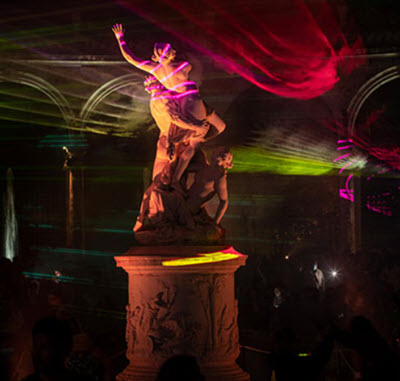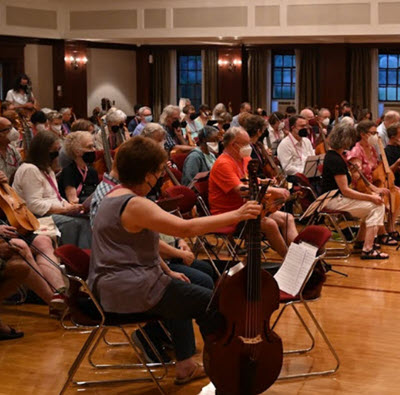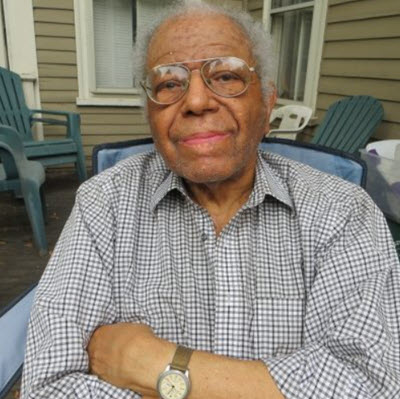by Philippa Kiraly
Published April 9, 2018
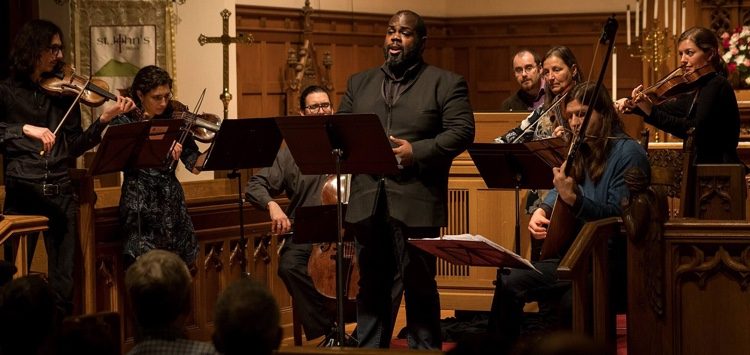
When you see Reginald Mobley, “singer” doesn’t come foremost to mind. He’s built like a refrigerator, big and square. If you did think “singer,” you might imagine an artist like Paul Robeson. In other words, as Mobley says, “large black men with the standard for subwoofer, shattering voices of God.”
But you’d be wrong. Mobley is a countertenor, a man who sings in the alto range after his voice has broken and uses a mix of falsetto and modal registers. (Modal is the register below falsetto, the one we use for speaking.) It’s something Mobley, 40, didn’t realize until he was in college, having sung tenor or baritone until then. A high voice was not considered something to be encouraged, he points out.
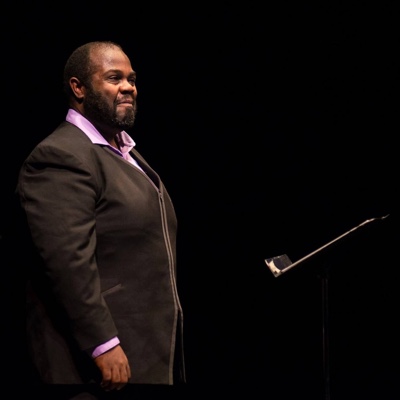
The sheer beauty of Mobley’s voice and the conviction that pervades all he sings have propelled him to a still-growing career, which so far has largely been based in Europe, often under the aegis of Sir John Eliot Gardiner, though performances in this country increasingly bring re-engagements for profoundly moved audiences.
Mobley, who’s called Reggie, was an architecture magnet high schooler in his native Florida intending to study art. He played trumpet and piano, with music as an extracurricular diversion. Needing choir members, the chorus teacher had him sing for her and got him a few voice lessons during his senior year, though he had already landed a visual arts scholarship to Davidson College in North Carolina.
Life intervened, Mobley says, and he started developing carpal tunnel syndrome. Casting around for an alternative to visual arts, he was able to change his scholarship to music at Oakwood College (now University) in Alabama.
“Once I got there, I mostly abandoned trumpet,” he says. “I sang as a tenor, tried composition and conducting, but it didn’t feel quite right.”
Transferring again, this time to the University of Florida in his hometown of Gainesville in 1999, Mobley joined the choir, singing tenor. On the side, for fun, he sang in a barbershop quartet, taking the top line, and this is where fate intervened dramatically.
“One day I was sitting with friends in a public area at the school and we were singing and my professor came around the corner and saw me playing around with the alto part,” says Mobley. “There was a stigma against countertenor singing, especially in the South, and I knew I wasn’t supposed to do it. He grabbed me and took me to his office, and there he played an E-flat major scale up and told me to sing it. So I did, tenor range, and he said, ‘Sing it where I’m playing it [an octave higher].’ So I did, and then he played more scales and had me sing them. And then the professor stopped and stared at me. He said, ‘Do you know what this is about?’ And I said, ‘I’m in trouble.’ And he said, ‘You are one of the most gifted countertenors I’ve ever met.’ And I said, ‘What’s a countertenor?’”
The professor, Jean-Ronald LaFond, happened to be a renowned voice teacher. He also happened to have studied at the University of Michigan at the same time as countertenor David Daniels, who would go on to a stellar career.
“I sang with him [Daniels] in his last production as a tenor, Britten’s Albert Herring,” says LaFond. “During a cast party, David shared his ‘other voice’ with us. As it turns out, he had been discouraged by his former teachers to use that voice. But our mutual teacher George Shirley recognized David’s special color and encouraged him to follow his heart. The rest is history, as they say. Three years later, I found myself teaching at the University of Florida and confronted a similar situation.”
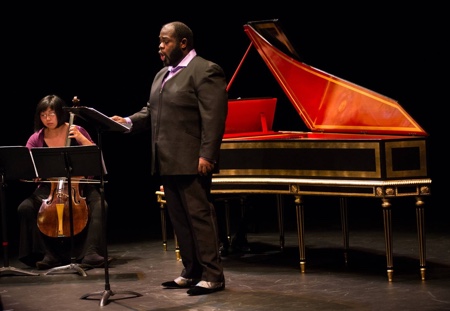
LaFond had Mobley listen to Daniels online and told him, “This is what you are going to be doing for the rest of your life.”
For Mobley, who was 22 at the time, it was a revelation. “I didn’t realize some of the voices I had been hearing for years — including Michael Chance — were men. I thought they were very large women dressed as men. I thought Michael was a weird spelling of Michelle. I’d had no exposure. These were all discoveries to me in college.”
“Reggie’s voice was unusually powerful,” says LaFond. “In teaching him, I wanted to capitalize on his more modal production while concentrating on encouraging fluidity and flexibility. It was important to me that the production should remain both powerful and flexible. Reggie was a dedicated student and an unusually sensitive musician.”
But it was all very disorienting to Mobley’s entire experience as a singer. He had assumed the struggles and resistance he had been having as a tenor were part of learning, and that the alto voice he possessed seemed too good to be true.
Mobley’s family had not wanted him to pursue a musical career. “Once they heard me, they couldn’t have been more supportive,” he says, “and it wasn’t even classical.” He had been cast in the title role of Rupert Holmes’ musical, The Mystery of Edwin Drood. He sang musical theater, cabaret, and jazz, but realized how much he loved Baroque music. He hadn’t listened to much of it until high school, but it seemed a natural extension of how he felt.
Like so many black professional singers, Mobley had grown up singing gospel and spirituals in the choir at his Bethel Seventh-day Adventist Church. “There is a connection in Southern black communities where this music is more practical, more integrated into life. You are taught that music is the expression of the soul. My parents and grandparents grew up in the American South in the 1930s and ’40s. I listened to my mother and grandmother, and they told me stories of people unjustly jailed, hung, lynched, but they couldn’t take our spirit. So singing became part of our resistance, even now.”
Mobley is featured on a new recording with San Francisco-based Agave Baroque titled Peace in Our Time (see EMA review here). It focuses on the 400th anniversary of the beginning of the Thirty Years’ War, one of the longest and most destructive in European history. “In Germany then, there was so much loss and suffering, the same sort of feeling, the same sort of calm and grieving, that I know all too well. It felt like part of me.”
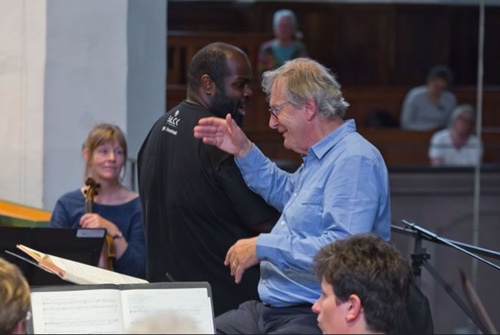
La Fond built his voice, says Mobley, and the late Roy Delp, another eminent voice teacher at Florida State, polished and refined it. LaFond, however, disputes Mobley’s assessment.
“I may have given Reggie a balanced foundation within the time we had, but Reggie’s success is entirely of his making. He is a determined, committed artist. No teacher builds a voice. We can only guide and give the tools, but the real work is done in the practice room. I am very proud of Reggie, and we are looking for opportunities to work together again.”
Since those college days, Mobley’s career has blossomed. From 2002 to 2004, he worked at Tokyo Disney as a singer-actor, largely as part of a barbershop quartet, with occasional solo gigs at a nearby USAF base. “It was an amazing experience, and one I miss terribly. I still haven’t felt at home anywhere as much as I did while living in Tokyo.”
Until three years ago, but now only occasionally, Mobley sang in Florida with Seraphic Fire, which performs everything from chant and Baroque music to modern masterpieces. He met Gardiner during a stint in Boston, and the British conductor almost immediately signed him up to sing St Matthew Passion with the Monteverdi Choir and English Baroque Soloists during the summer of 2016, followed by a December Magnificat and a Monteverdi opera project. Mobley performed several concerts with the Academy of Ancient Music last year and has been singing with Agave Baroque and other early-music groups, as well as in Mexico, Canada, Scotland, and the United Kingdom, which, he says, “has kind of taken to me.”
Like a diamond that merely needed careful attention to bring out its quality, Mobley has one of the most beautiful voices in any range. After a Seattle concert in February at which he sang music of 200 years of black composers, the respected voice teacher and performance practice coach Nancy Zylstra was overwhelmed.
“What a gorgeous voice!” she said. “Top to bottom, just plain gorgeous. He’s got high notes and low notes and everything in between, and his fantastic technique allows him to move seamlessly between registers, a real accomplishment for a countertenor. His command of dynamics is smooth and perfectly calibrated over the length of a note or phrase. His diction is always clear.
“Then there’s his exquisite musicality and expressivity, which includes the storytelling aspect of the ‘singerly’ arts. Based on these two hearings, I’d say Reggie is all about the music, all the time: such beautiful phrases, unmarred by excessive attention to small repetitive or sequential rhythmic figures — all the little notes are clear, but they don’t take over the phrase.”
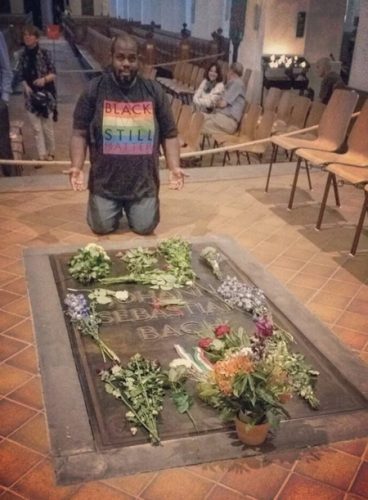
In his spare time, Mobley, who lives in Boston, has become a political activist. He worked last year on behalf of a city councilor who was running for mayor. This month, he may be heading a masterclass/seminar on social justice and activism in the arts when he’s in residence at Whitman College in Walla Walla, WA, where he’ll be a soloist in the Mozart Requiem on April 27 and two days later in Spokane.
Mobley has more concerts coming up at which he can convey his convictions and passion through his voice. After Spokane, he heads to the U.K., where he joins Gardiner for a long cantata tour through Europe in May and June. He’s back in Washington State in July to sing Bach cantatas at the Whidbey Island Music Festival.
He confesses to a yen for comics, while still sketching a bit. He enjoys that his career is still growing, but where he really wants to make his mark, he says, is in the “destigmatizing of (Baroque music) as this dying art of elite white people.”
“In Baroque times, this was the art of craftsmen,” Mobley continues. “There was no wall. I want to somehow remind American audiences to invest in this. Music has a unifying purpose. I want to work to reverse some of the whitewashing in music, that the only composers who ever existed were just old white men in wigs. Not so, but women, people of color, gays, not just one particular group. We have to make people realize this is extremely relevant in a world that is so unbelievably busy and secular. We are taught to see what we do as not relevant. There are several hurdles to cross before we can start pulling in those crowds. How do we figure out how to approach this demographic?”
Philippa Kiraly has been a freelance classical music critic since 1980. She wrote for the Akron Beacon Journal, then the Seattle Post-Intelligencer until its print demise, and now for City Arts and a blog, The Sun Break.

